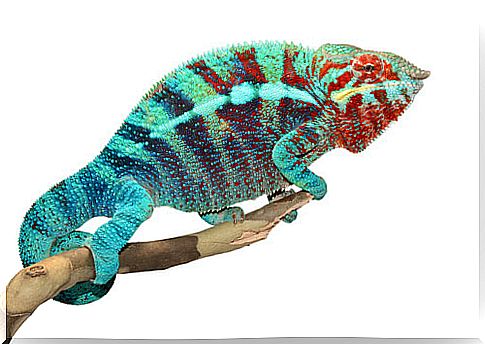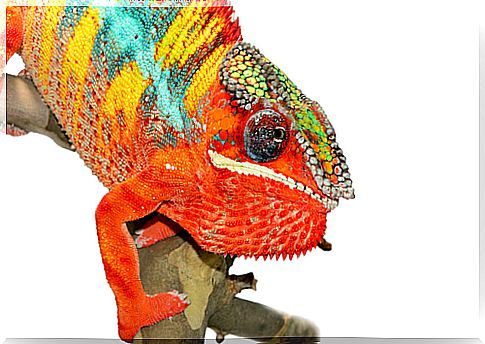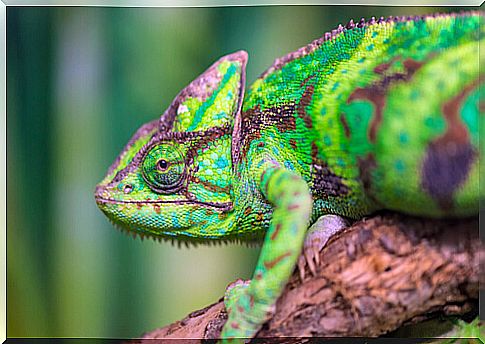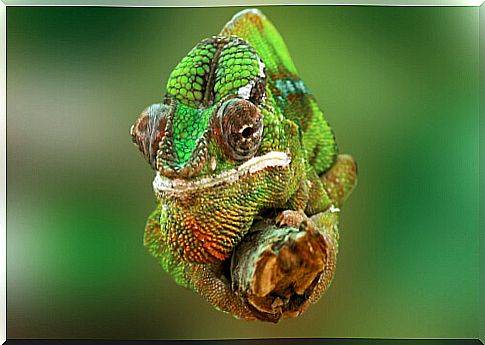Why Does Chameleon Color Change Occur?

The color change in animals is a process that has always amazed us. In most living things, the coloration is associated with dead tissues such as the exoskeleton, scales, feathers, and hair, and is relatively fixed. Still, some species are capable of rapid color change. This property allows them to display different colors and patterns in response to changing environmental contexts.
Is there a difference between the color change and the pattern change?
As we mentioned before, some taxa such as cephalopods, fish, and reptiles have the ability to change their color during interactions with other organisms. Among all of them, chameleons (family Chamaeleonidae ) represent an intriguing case for research. Unlike organisms that experience a localized color change, chameleons can change body colorations and patterns during social interactions.
The chameleon’s color change in response to temperature
The first thing to note is that chameleons are ectothermic animals. This means that they are not capable of generating, by themselves, their own internal heat. For this reason, all ectothermic organisms depend on external heat sources to reach a certain body temperature.
It is important to bear in mind that many of the traits that an ectothermic animal expresses change substantially as a function of the individual’s body temperature. These traits include speed of digestion, agility when running or swimming, and color among others.
That said, we must consider that dark colors absorb light and therefore heat, while light colors reflect it. Therefore, the color change strategy is easy to understand for anyone who, on a summer day, has spent time in a black car in the bright sun. Chameleons know this, and they use their skin color as a thermostat to control the temperature they receive from the environment.

Dressing to Impress: The Color Change Strategy
The second reason chameleons change color is also a familiar concept to humans : self-expression. This is the case of humans who change our outfits or hairstyles to suit our mood. Chameleons also change their colors based on their mood.
Normally, the chameleon darkens its colors when it is afraid and brightens them when it is excited. Also, there is a difference between males and females: males change color more often than females, who tend to use more subtle signals to communicate.
In this sense, the change in color in male chameleons can help them attract a mate. By showing itself in striking tones, it sends a signal of a healthy state to females. Conversely, moving to dark tones can show another male that he is willing to fight. For these reasons, a chameleon can alternate between several different looks each day to suit the occasion.
The science behind the magic of color change
Scientists previously believed that chameleons changed their color similar to how octopuses and squid do. That is, to alter their appearance they made use of sacs full of pigments in cells called chromophores in the skin. However, the chameleon’s color change has been found to be even more complex.
Chameleon’s skin has colors produced by pigments, colored compounds that are synthesized or accumulated in cells. Thus, there is a range of colors that result from the presence of melanins, pterins and other chemical pigments.
The upper layer of the chameleon’s skin is made up of cells that contain pigments : if it is yellow they are xanthophores, if it is red, erythrophores. These pigmented cells are mainly present in striped regions. The deepest layer is made up of melanophores, which have extensions that reach the top layer of the skin.
On the other hand, the skin of the chameleon has another type of coloration by structure, which is due to the presence of reflective nano-structures. These nanostructures are present in specialized cells called iridophores. They are produced from the guanine content of the cell and produce iridescent metallic colors when interacting with light.

How do iridophores work to make color changes?
It should be noted that iridescence is the optical phenomenon by which the perceived color is associated with the angle at which the light falls on the reflecting surface. That said, we can understand how the chameleon’s iridophores work.
A recent study determined that the skin of panther chameleons have two types of iridophores cells: the superficial ones, which they called S-iridophores located in the layer closest to the epidermis, and the D-iridophores, in a deeper layer.
In addition, each species of chameleon has S-iridophore cells with their guanine crystals of different sizes, shapes and distribution. This layer of S-iridophores is responsible for the rapid color changes in the visible light spectrum.
Additionally, crystals in D-iridophores mostly reflect near infrared light (700–1400 nm). Thus, the researchers point out that the function of the D-iridophore layer is to regulate the temperature when the animal is under intense solar radiation.
How does the color change happen so suddenly?
It is interesting to know that in the skin of the chameleon in a relaxed state, the nanocrystals in the S-iridophore cells are grouped close to each other. In this state, the effective refractive index is optimal for the wavelengths of the color blue.
On the other hand, in a state of excitement, signals mediated by hormones or neurotransmitters are generated, induced by changes in mood, temperature, or stress. In response, the S-iridophore cells change the arrangement of the nanocrystals. In this way, as its distribution is spaced, the effective refractive index is lower, and the reflectivity in the visible spectrum increases for red, orange and yellow colors.
Ultimately, all these color production mechanisms are orchestrated to give the chameleon the appearance. For example, the green color on your skin is the result of yellow and blue wavelengths. The combination of the yellow of the xanthophores, plus the blue light reflected by the iridophores, produces the vibrant green color that causes us admiration.

Final note
The chameleon’s dynamic coloration likely drove the evolution of these complex visual cues. The species’ rich repertoire of chromatic elements reveals the importance of this communication code in its social interactions and other behavioral contexts.









